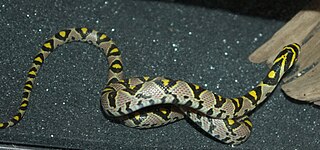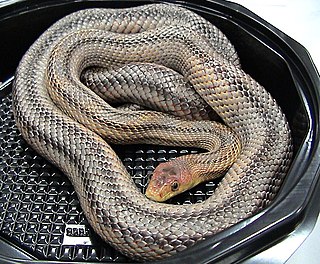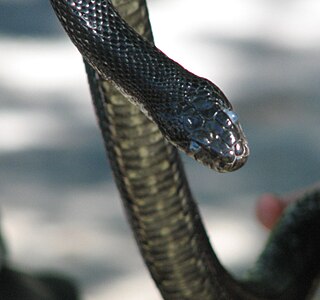
Rat snakes are members – along with kingsnakes, milk snakes, vine snakes and indigo snakes – of the subfamily Colubrinae of the family Colubridae. They are medium to large constrictors and are found throughout much of the Northern Hemisphere. They feed primarily on rodents. Many species make attractive and docile pets and one, the corn snake, is one of the most popular reptile pets in the world. Like all snakes, they can be defensive when approached too closely, handled, or restrained. However, rat snake bites are not dangerous to humans. Like nearly all colubrids, rat snakes pose no threat to humans. Rat snakes were long believed to be completely nonvenomous, but recent studies have shown that some Old World species do possess small amounts of venom, though the amount is negligible relative to humans.

Pantherophis obsoletus, also known commonly as the western rat snake, black rat snake, pilot black snake, or simply black snake, is a nonvenomous species of snake in the family Colubridae. The species is native to central North America. There are no subspecies that are recognized as being valid. Its color variations include the Texas rat snake. Along with other snakes of the eastern United States, like the eastern indigo snake and the eastern racer, it is called “black snake”.

Elaphe is a genus of snakes in the family Colubridae. Elaphe is one of the main genera of the rat snakes, which are found in many regions of the northern hemisphere. Elaphe species are medium to large constrictors by nature.

The mandarin rat snake is a species of nonvenomous colubrid snake endemic to Asia. It is closely related to Euprepiophis conspicillata, the Japanese forest rat snake. Mandarin rat snakes are one of the most popular rat snakes found in the pet trade.

Oreocryptophis porphyraceus is a rat snake species, commonly called the black-banded trinket snake, red bamboo snake, found in mid to upper-level elevations of forested hills in southeastern Asia, ranging from evergreen tropical to dry seasonal forests depending on the subspecies and locality. It is the only member of the genus Oreocryptophis, but it was formerly placed in Elaphe.

Gonyosoma prasinum is a species of colubrid snake found in Asia.

Coelognathus radiatus, commonly known as the radiated ratsnake, copperhead rat snake, or copper-headed trinket snake, is a nonvenomous species of colubrid snake.
The eastern trinket snake is a species of snake in the family Colubridae. The species is endemic to South Asia.

Pantherophis emoryi, commonly known as the Great Plains rat snake, is a species of nonvenomous rat snake in the family Colubridae. The species is native to the central part of the United States, from Missouri to Nebraska, to Colorado, south to Texas, and into northern Mexico.

Pantherophis bairdi is a species of harmless snake in the family Colubridae. The species is native to the southwestern United States and adjacent northeastern Mexico. No subspecies are recognized as being valid.

The Japanese rat snake is a medium-sized colubrid snake found throughout the Japanese archipelago as well as on the Russian-administered Kunashir Island. In Japanese it is known as the aodaishō or "blue general". It is non-venomous. It is hunted by eagles and tanukis.

Elaphe schrenckii is a species of nonvenomous snake in the family Colubridae. The species is indigenous to Northeast Asia.

Elaphe carinata, the king ratsnake, is a species of Colubrid snake found in Southeast and East Asia.

Coelognathus is a genus of seven species of rat snakes in the subfamily Colubrinae of the family Colubridae. The species, which are native to South Asia and Southeast Asia, were formerly assigned to the genus Elaphe. Based on morphological evidence and protein similarities, in 2001, Helfenberger revalidated the name Coelognathus that had originally been proposed by Leopold Fitzinger in 1843. The distinction between Coelognathus and Elaphe was further supported by mitochondrial DNA sequence and additional morphological evidence in 2005.

Pantherophis alleghaniensis, commonly called the eastern rat snake, is a species of nonvenomous snake in the family Colubridae. The species is endemic to North America.

The Transcaucasian ratsnake, also commonly known as the Gavand snake, is a species of nonvenomous ratsnake in the family Colubridae. The species is native to Western Asia and the Middle East. There are three recognized subspecies.
Euprepiophis perlaceus, also known as Sichuan rat snake or pearl-banded rat snake, is a species of snake in the family Colubridae snake. It is endemic to western Sichuan Province in China. This snake is designated as Endangered by the IUCN Red List. It is found in the Palearctic.


















